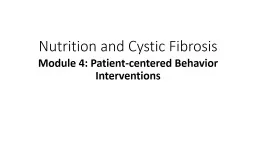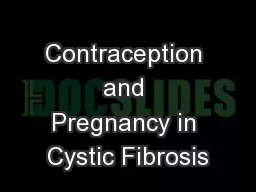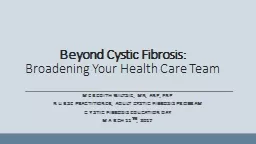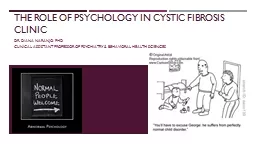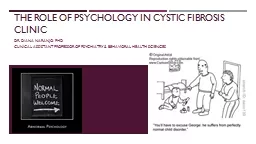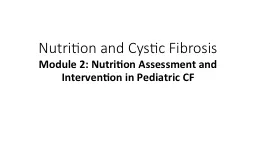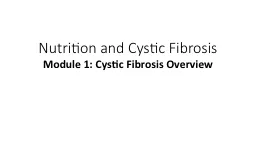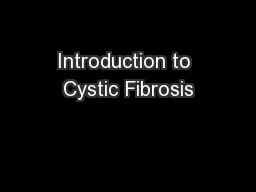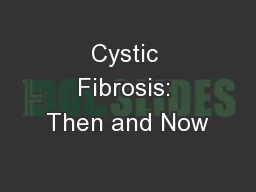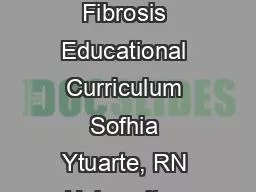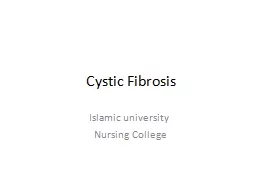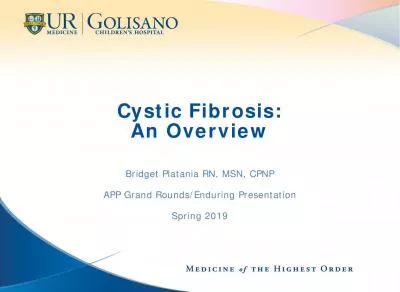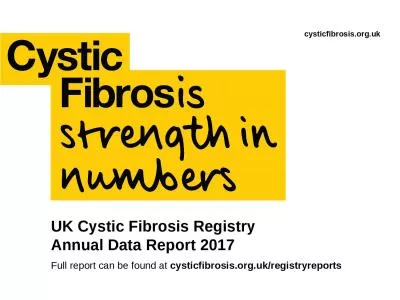PPT-Nutrition and Cystic Fibrosis
Author : tatiana-dople | Published Date : 2017-09-28
Module 4 Patientcentered Behavior Interventions Learning Objectives Describe effective strategies for facilitating behavior change in patients Discuss the impact
Presentation Embed Code
Download Presentation
Download Presentation The PPT/PDF document "Nutrition and Cystic Fibrosis" is the property of its rightful owner. Permission is granted to download and print the materials on this website for personal, non-commercial use only, and to display it on your personal computer provided you do not modify the materials and that you retain all copyright notices contained in the materials. By downloading content from our website, you accept the terms of this agreement.
Nutrition and Cystic Fibrosis: Transcript
Module 4 Patientcentered Behavior Interventions Learning Objectives Describe effective strategies for facilitating behavior change in patients Discuss the impact of parentalcaretaker life course on disease management and overall health of the pediatric CF patient . Treatment . of Cystic Fibrosis. Rebekah F. Brown, MD. Center Director, Cystic Fibrosis Center at Vanderbilt. Objectives. At . the end of this presentation, participants will have an understanding of the pathophysiology of cystic fibrosis and targets of treatment for children and adults with cystic fibrosis.. What You Need to Know. Jennifer Cannon, NP-C. Adult Cystic Fibrosis, Stanford Health Care. March 13, 2016. Overview. Contraception. Importance of Contraceptive Education. Current Research: Contraception in Cystic Fibrosis Patients. Broadening Your Health Care Team . Meredith Wiltsie, MN, ANP, FNP . Nurse Practitioner, adult Cystic Fibrosis program. Cystic Fibrosis Education Day. March 11. th. , 2017. No disclosures. If you are a CF Center patient, why do you need a Primary Care Physician? . Dr. Diana Naranjo, . Phd. Clinical Assistant Professor of Psychiatry & Behavioral Health sciences. Why I’m here. Dramatic improvements in prognosis, treatments and life expectancy in CF; . However, arduous . Dr. Diana Naranjo, . Phd. Clinical Assistant Professor of Psychiatry & Behavioral Health sciences. Why I’m here. Dramatic improvements in prognosis, treatments and life expectancy in CF; . However, arduous . Module 2: . Nutrition Assessment and Intervention in Pediatric CF . Learning Objectives. Determine appropriate energy, macronutrient, and micronutrient needs for pediatric patients with cystic fibrosis.. Module 1: Cystic Fibrosis Overview. Learning Objectives. Describe the pathophysiology of cystic fibrosis, and specifically how the disease process alters nutrient digestion, absorption, and metabolism.. . Single gene . Mendelian. disorder. Gene codes for the Cystic Fibrosis . Transmembrane. Conductance Regulator protein (CFTR). Daniel R. . Taub. and Joshua Page. Cystic Fibrosis: Exploration of evolutionary explanations for the high frequency of a common genetic disorder.. by. Kathleen A. Nolan and Allen J. . Burdowski. . Biology . and Health Sciences. St. Francis College, Brooklyn, NY. NATIONAL CENTER FOR CASE STUDY TEACHING IN SCIENCE. Students, before coming to class you should have:. dion. By: Alex-. A. nn and . Noémy. Personal. information. She’s. . forty. - . eight. ( 48 ) . years. . old. .. S. he. . was. . born. in March. . the . thirty. ( 30 ), . nineteen. . sixty. Table of Contents Presentation 5 Presentation Resources 6-7 Teacher/Faculty Curriculum 8-9 Teacher/Faculty Resources 10 K-2nd Grade Activities/Materials 11 3rd-5th Grade A Nursing College. Cystic Fibrosis. Inherited—. autosomal. recessive. Both parents must be carriers. Each child has a 1 in 4 chance of being affected. Affects primarily white children. Father Mother. ObjectivesUnderstand the genetic abnormality causing cystic fibrosis (CF) and the newborn screen processRecognize the multiple organ systems affected by CFIdentify common treatments /medications and m Annual Data Report 2017. Full report can be found at . cysticfibrosis.org.uk/. registryreports. 1.1 Summary of the UK Cystic Fibrosis Registry . UK Cystic Fibrosis Registry Annual Data Report 2017. 1.2 Age distribution by gender .
Download Document
Here is the link to download the presentation.
"Nutrition and Cystic Fibrosis"The content belongs to its owner. You may download and print it for personal use, without modification, and keep all copyright notices. By downloading, you agree to these terms.
Related Documents

